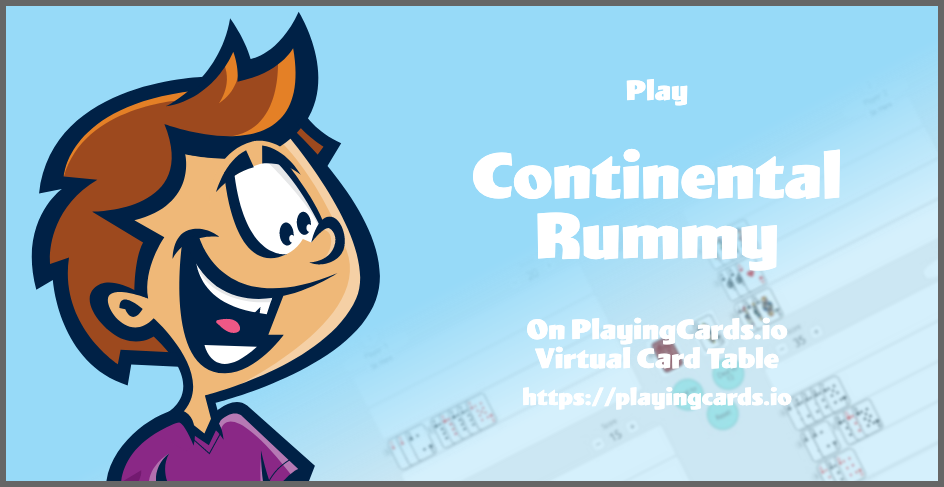Continental Rummy (May I?) on PlayingCards.io

A variant of Contract Rummy where players build sets and runs, trying to empty their hand as quickly as possible. Also known as May I? or Continental May I? rummy.
Objective
- The ultimate goal of Continental Rummy is to be the player with the lowest score at the end of seven rounds.
- Games consist of seven hands, each with its own rules governing which melds must be played first.
- Players take turns building two types of melds (sets and runs) and adding cards to existing melds.
- When a round ends, each player is assigned points based on the cards in their hand.
- The goal is to be the first player to "go out," or play all of the cards in their hand on their turn, thus keeping their score as low as possible.
Set Up
- To determine how many decks to use, divide the number of players by two, rounding up. Two, three, or four players will use two decks, while five or six will use three. Each deck is a standard 52-card pack plus one Joker.
- At the beginning of play, each player draws a card from the deck. The player with the highest card deals first.
- Shuffle the cards together, then deal each player a hand of ten cards. The remaining cards are placed face-down to form the draw pile.
- Flip the top card of the draw pile face-up and place it to the side to start the discard pile.
- The person to the dealer's left goes first. Play then passes clockwise.
Playing the Game
- A player's turn begins by taking either the top card from the draw deck or the top card from the discard pile.
- If the player does not want the discard card, the next player has a chance to immediately claim it. If they don't want it, the following player may claim it, and so on. Whoever does take the discard card must also draw the top card from the draw pile as a penalty.
- The original player's turn then continues. Each round has a sequence of sets/runs players must complete first (see chart below). A set is three or more cards of the same face value (four Queens, three sevens). A run is four or more cards of the same suit in a sequence, like J-Q-K-A of spades. Aces are either high or low, but they can't be both in the same meld, and runs may not be more than 13 cards. Jokers are wild.
- First Meld Requirements
- Round 1 - Two sets
- Round 2 - One set, one run
- Round 3 - Two runs
- Round 4 - Three sets
- Round 5 - Two sets, one run
- Round 6 - Two runs, one set
- Round 7 - Three runs
- Satisfying the round's meld requirements is called "going down." Once a player goes down, they may not create new sets or runs, only play new cards onto sets/runs that are already on the table (both their own melds and other players' melds). If a player cannot go down, play continues as normal.
- After laying down sets/runs, if they're able, players signal the end of their turn by discarding a card onto the discard pile.
- The round ends when a player "goes out," or empties their entire hand. Scores are then tallied (see Scoring below).
- For the new round, the player to the left of the previous dealer becomes the dealer. Note that in the final rounds, two extra cards will be dealt out:
- Rounds 1, 2, 3, 4 - Deal 10 cards to each player
- Rounds 5, 6, 7 - Deal 12 cards to each player
Taking a Turn
- Player 1 either draws a card or takes the top discard card.
- If the player does not take the discard card, other players may claim it.
- Player 1 attempts to empty their hand by playing the round's required sets/runs and by playing cards onto existing melds.
- When no more cards can be placed, the player discards a card and their turn ends.
Scoring
When any player empties their hand the round immediately ends.
Points are assigned to each player for the total value of cards in their hand:
- Ace, Joker - 15 points each
- 8, 9, 10, Jack, Queen, King 10 points each
- 2, 3, 4, 5, 6, 7 - 5 points each
Once the score is tallied, the player to the left of the dealer becomes the new dealer.
Play continues as normal, starting from the next round. Use the Current Round counter to keep track.
Once the seventh round is complete, final scores are tallied. The player with the lowest score wins.
Welcome!
PlayingCards.io is an online play space which allows you to play any tabletop or card game directly in your browser, multiplayer with your friends, for free. No app install is needed.
Create a room and share the room code to get started.